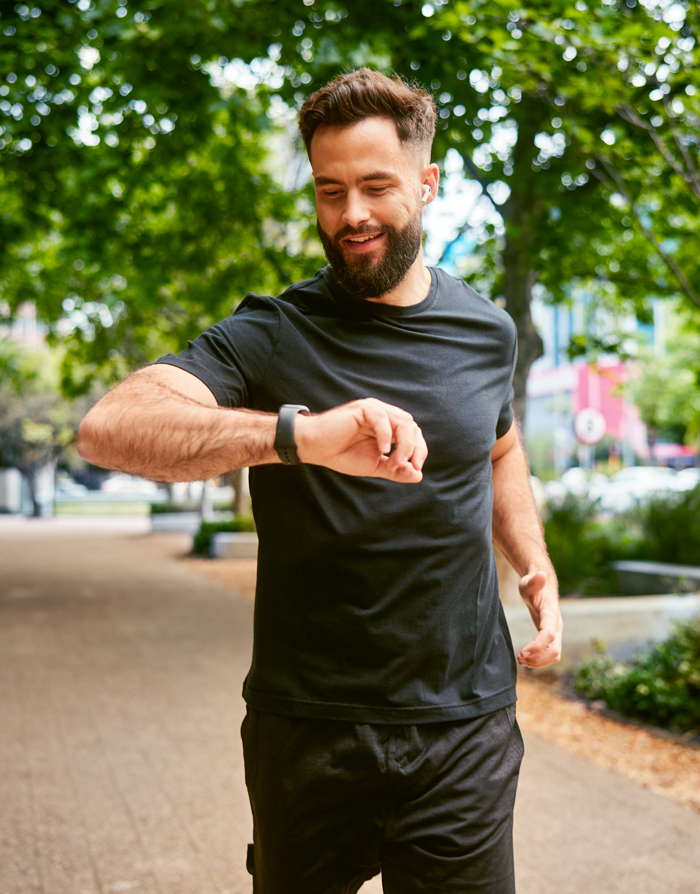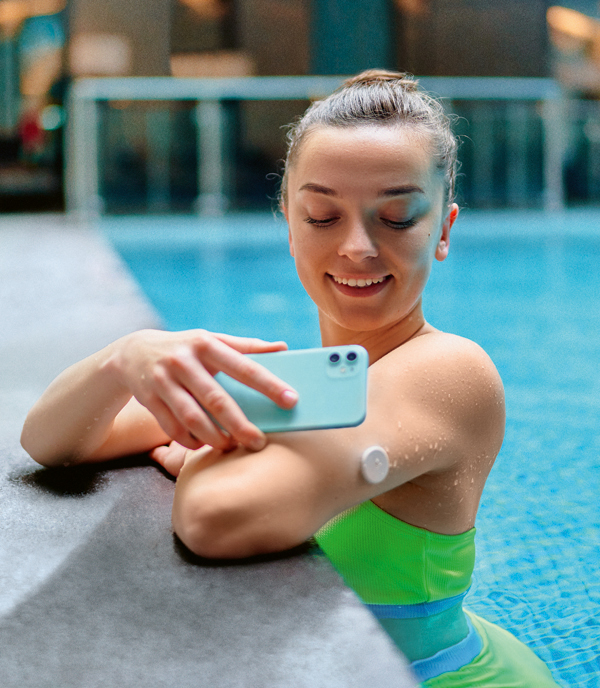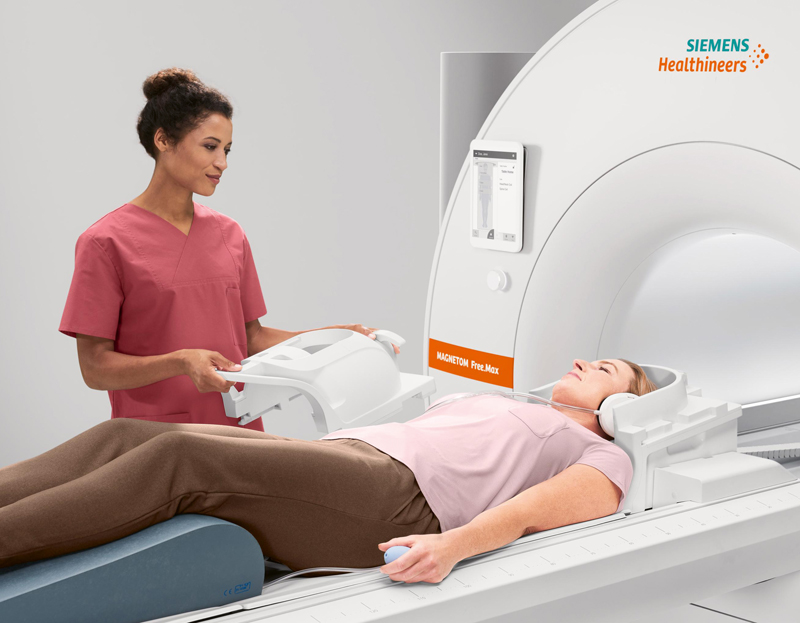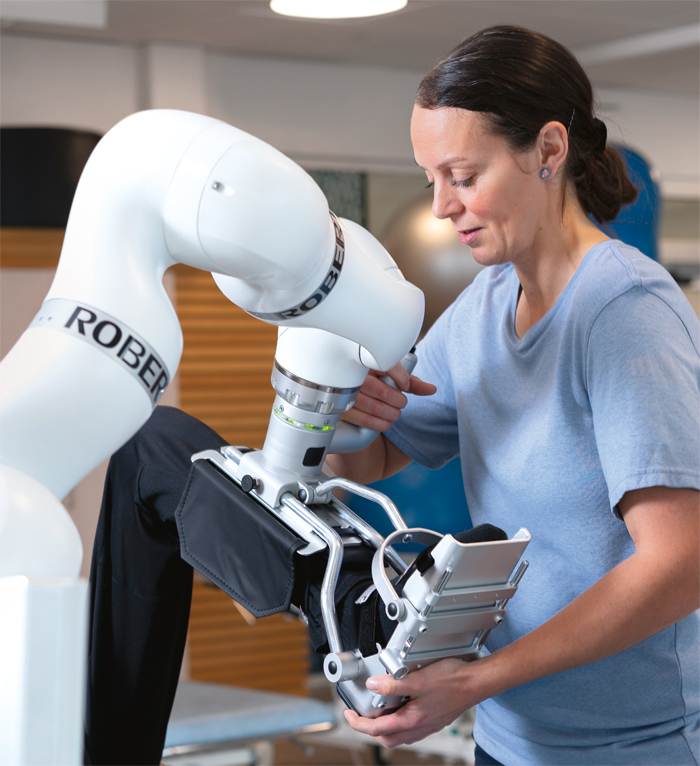Healthy progress
Modern technology makes it possible: smart watches show blood pressure and heart rate, GPs analyse blood samples on the spot and MRI scans take place directly in the specialist practice. Healthcare technologies play a decisive role here by enabling an active lifestyle as well as early detection and treatment of diseases.
Many people’s understanding of health has changed significantly as a result of digitalisation and modern technologies. In particular, simple self-monitoring with the help of wearables that measure bodily functions has transformed health from being mainly a matter for medical practitioners into daily routine. We are also observing a general shift from reactive healthcare to a more proactive approach, because potential health risks can now be better anticipated and mitigated.
The fact that not only fitness trackers and smart watches are increasingly easy to handle while offering ever more performance, but also the high-tech equipment in doctors’ surgeries and clinics, is an important aspect in this connection. For example, progress in point-of-care testing would be impossible without high-performance analysers. And in clinical treatment, modern medical technologies not only make therapies more effective but reduce their duration too.
Reliable and robust medical devices – including the components installed in them – lay the foundation for advances in healthcare technology, whether for personal or professional use. New and further technological developments have benefits for people at all stages of life – from healthy living and prevention through diagnosis and treatment to rehabilitation. (see graphic, left).
Wearables as a growth market
“Statista Market Insights: Digital” estimates that by 2027 the total market volume for smart watches and fitness trackers will have grown to more than 90 billion US dollars, in other words it is expected to double within just five years.

Tracking physical parameters such as blood oxygen saturation and pulse rates with wearables is an integral part of their training for many people
The manufacturers – mostly high-tech corporations such as Apple, Samsung and Xiaomi – have thus become relevant players in the healthcare sector. Michael Snyder, Professor of Genetics at Stanford University, sees enormous potential here. With billions of people around the world owning a smartphone, “If you could combine that with a 50-dollar smart watch, you’d have a health monitoring system.”
As measurements get more and more accurate and certain features receive certification as medical devices, the relevance of wearables for medical research and practice is also increasing. Jamie Robertson, Co-Director of the Foundations of Clinical Research programme at Harvard Medical School, confirms this: “Wearables make it much more accessible than ever to get biological measurements from people during a study”. The range of applications is constantly expanding too, opening up new opportunities for early detection of diseases. In addition to classic parameters like heart rate, blood pressure or body temperature, information on the human body can nowadays also be provided at the molecular level.
Electrochemical sweat sensors, for instance, allow the body’s blood sugar level and its electrolyte or fluid balance to be tracked in real time. Professor Snyder believes that even more possibilities exist for wearable-based analytics: “Infectious diseases, anaemia, even type II diabetes. And then in the future, I’m pretty confident there’s other things, for sure, heart conditions.” According to Snyder, researchers are also investigating the suitability of these devices for detecting cancer.
Another important indicator of health is breath, which contains around 3,000 volatile substances. Amongst other things, the intake of carbohydrates causes the amount of carbon dioxide in a person’s breath to increase more than after the intake of fats. This information can be used to gauge the state of that person’s metabolism based on the air they breathe and work out a diet and exercise plan to match, for instance as a starting point for losing weight.

Amongst other things, modern sensors enable blood sugar levels to be monitored automatically in real time
Development of customised materials
The devices and sensors employed for such applications must be able to withstand constant skin contact or mechanical stress due to influences like shock or vibration. Wevo offers tailormade solutions for this purpose that significantly extend the life of the electronics without compromising wearing comfort. Innovative materials are also indispensable for the development and the manufacture of modern medical technology in hospitals and doctors’ surgeries. Wevo materials provide reliable, long-term protection for sensitive components. Their superior resistance to effective – and in practice aggressive – disinfectants and cleaning agents is crucial for ensuring the sterility of medical devices.
Innovative diagnostics
New and improved materials play a similar key role when it comes to new technologies in the field of diagnostic imaging.
The combination of stronger magnetic fields and artificial intelligence allows higher image resolution and makes it possible to detect microstructures that could sway the decision for or against a particular kind of treatment.
Moreover, the examination can be completed in half the time. Thanks to smaller, lighter and hence mobile MRI scanners, examinations can be carried out anywhere. “In the United States, for example, such devices are mainly used in rural areas. In the UK, they’re very popular in urban centres to shorten waiting times for examinations”, explains Andreas Schneck, Head of Magnetic Resonance at Siemens Healthineers.
Apart from Siemens Healthineers, the list of top medical device companies also includes Medtronic, Johnson & Johnson and Fresenius – established manufacturers from the US and Germany (see graphic on page 36). According to MedTech Europe, the European trade association representing the medical technology industries, the European market alone was estimated to be worth around 160 billion euros in 2022. With a global market share of just under a third, Europe ranked second only to the United States, which accounted for over 40 per cent.
The number of patents is a further indicator of the industry’s innovative strength. In Europe, nearly 16,000 applications were submitted in 2022, putting technological developments in the medical sector in second place overall. According to Robert Langer, Professor of Medical Science and Engineering at the Massachusetts Institute of Technology, this innovation potential is the outcome of collaboration between many specialist areas: “The spectrum ranges from chemistry, biology and physics through medical sub-disciplines like immunology, molecular biology and anatomy to engineering and product design”. Progress here is accelerated by the findings of each individual discipline.

The new MRI generation from Siemens Healthineers uses artificial intelligence to simultaneously shorten examination time and increase image resolution
Diagnosis and treatment of chronic diseases
These new technological options mean that chronic diseases can potentially be recognised earlier and hence treated more effectively – as well as relatively easily. The German Heart Foundation points out, for instance, that some smart watches can already support the diagnosis of cardiac arrhythmia. An Israeli company called MetaFlow provides another example here. The firm commissioned a scientific study on the effectiveness of its Lumen metabolism tracker for prediabetes. Researchers at the Tel Aviv Sourasky Medical Centre confirmed that the device can help to positively influence the factors involved in the development of type 2 diabetes mellitus. According to the Drug Commission of the German Medical Association, between 6 and 8 per cent of the world’s population are affected by this metabolic disorder.
The search for alternative diagnostic and treatment methods for diabetes is ongoing. Sensors that continuously record blood sugar levels on or underneath the skin are already in use today. And for several years now, researchers have been investigating a contact lens that is capable of monitoring blood glucose concentrations. Yet whereas Novartis, the pharmaceutical giant, shelved the development project with Google parent company Alphabet, scientists at Stanford University in cooperation with Pohang University in Korea have succeeded in building a functional model by using other materials.
Potential of minimally invasive surgery
Minimally invasive surgery is commonplace today, and it serves as an excellent illustration of progress and innovation. In many cases, it is suitable for performing surgical procedures via small incisions or natural body openings. According to Siemens Healthineers, the benefits include minimal treatment times, greater standardisation of clinical procedures and ultimately better clinical outcomes. Here, too, technological advances are making many things possible and helping surgeons to perform procedures more safely and with more precision than ever before. Robot-assisted surgical systems allow instruments inserted into the body to be controlled accurately to the millimetre. And at the same time, the integration of high-resolution images in 3D enables more and more possibilities in a range of surgical disciplines.
Technology-enhanced rehabilitation
Modern technologies can ensure a speedier recovery following an operation, injury or illness. New procedures are combined with tried-andtested methods. Researchers at MIT, for example, have developed a textile that can be used to manufacture “smart” shoes for patients who are having to learn how to walk again after an injury. The precision of the woven-in pressure sensors was significantly improved by using thermoforming.

Rehab robots from Life Science Robotics can repeat movements learned any number of times and thus relieve healthcare professionals from physical strain
Following a stroke, too, the aim of rehabilitation is to restore bodily functions as quickly as possible and teach compensation strategies. Exoskeletons or smart gloves can provide vital support to patients here and be a source of therapeutic insights. Robot-assisted therapy and patient mobilisation open up many new options as well.
The rehab robot from Danish company Life Science Robotics, ROBERT, was based on a KUKA lightweight robot. It promotes active and passive mobilisation and can repeat movements that it has been taught by a carer autonomously.
Healthcare technologies in tomorrow’s world
Innovative healthcare technologies improve everyday living quality and enhance medical treatment. For society, they are an opportunity to confront challenges such as demographic change, the skills shortage or the growing number of chronic diseases. Advances in materials, sensors and energy sources, amongst other things, can pave the way here. Wearables, in particular, will play an ever greater role where prevention is concerned: in the future, they will be even smaller and function even more precisely. According to Dr. Veena Misra, Director of the National Science Foundation-funded ASSIST Centre at North Carolina State University, where researchers are working on the next generation of health wearables, they could eventually become “invisible”, blend into clothes or adapt to the body. MIT professor Robert Langer, too, is confident that other sectors will benefit enormously from these innovations: “Healthcare technologies are already driving progress in numerous fields today – and they’re set to become an even bigger driver of innovation in the future”. In short, technology is – literally – the key to healthy progress.
Image sources: Image 1: praetorianphoto, Image 2: Goodboy Picture Company, Image 3: Goffkein, Image 4: Siemens Healthineers, Image 5: Life Science Robotics ApS
Links related to this article
Companies/research institutes:
Harvard Medical School
Massachusetts Institute of Technology
Stanford University
Stanford University (Stanford Healthcare Innovation Lab)
European Patent Office
KUKA
Lumen
Siemens Healthineers
Disclaimer (Extract) – Copyright and IP Rights: The contents published on this website are subject to German copyright and ancillary copyright law. Any utilization not permitted by German copyright and ancillary copyright law requires the prior written permission by the provider or the respective owner. This applies in particular to the copying, working, translation, storage, processing and reproduction of contents in databases and other electronic media and systems. Third-party contents and rights are identified as such in this regard. The unauthorised duplication and forwarding of individual contents or complete pages is not permitted and may possibly be punishable as a criminal offence. Only the creation of copies and downloads for personal and private and non-commercial use is permitted. The use of this website as external link shall only be permitted upon prior written approval oft he provider. Each and any firm or trademark is sole property of the relevant company. Citations of trademarks and names of third parties have a purely informative character. You will find the complete disclaimer in the imprint.